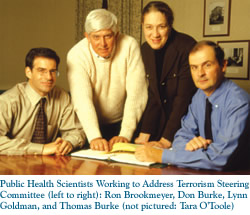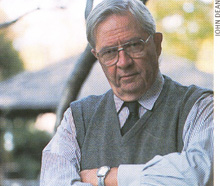|

Mobilizing Public Health
 Turning
Terror's Tide with Science Turning
Terror's Tide with Science
Responding to the September outbreak of terrorism in America,
senior School leadership launched in late October a new comprehensive
public health initiative to tackle the complex scientific, social,
and governmental issues raised by bioterrorism.
"The School recognizes that this is a national public health
emergency. The School has, in many ways, unequaled expertise in
the issues related to the acute and urgent problem of anthrax bioterrorism
and the longer range strategic issues related to all manner of terrorism,"
says Dean Al Sommer, MD, MHS '73. "Whether it comes through
letters or aerosol sprays or poisoning of water or the food system,
it's the responsibility of the School to come to our nation's defense."
In the coming months, more than 60 faculty members will work on
bioterrorism preparedness, devise new technologies for detecting
anthrax, determine the best therapies, study available antibiotics,
and recommend how to best contain outbreaks of anthrax and other
biologic, chemical, and nuclear hazards.
The School has a three-pronged goal of providing a scientific basis
for rational action, timely and accurate advice for the public and
professionals, and training modules for targeted audiences, delivered
by the Web, simulcasts, and CD-ROMs.
The new initiative, called Public Health Scientists Working to Address
Terrorism (SWAT), will work closely with a related University-wide
effort. Thomas Burke, PhD, MPH, an associate professor in Health
Policy and Management, is the initiative's director. Other steering
committee members include Biostatistics professor Ron Brookmeyer,
PhD; International Health professor Don Burke, MD; Environmental
Health Sciences professor Lynn Goldman, MD, MPH '81; and Tara O'Toole,
MD, MPH '88, the director of the Center for Civilian Biodefense
Strategies. Two to four faculty members from each of the School's
nine departments have been asked to devote the next month or two
to providing immediate input to the effort. The initiative will
draw on the broad spectrum of the School's expertise, including
surveillance, environmental assessment and clean-up, infectious
disease and antimicrobial resistance, vaccine development and testing,
legal issues, disaster management, and communication.
The short-term efforts do not mean abandoning the School's long-standing
research and teaching priorities, according to Sommer. Rather, the
short-term work is a "unique activity in the history of the
School in response to an urgent national need," he says. "I
don't know of any time in the School's history that this has been
done."
Thomas Burke envisions teams of public health researchers, focusing
on specific areas and providing technical assistance and guidance
and help with communication between the government, public health
professionals, and the public. The teams would also bring public
health risk assessment, epidemiology, and other tools to provide
advice on treatment and management of both patients and the "worried
well."
Front-line professionals from across the nation will come to the
School for seminars on the latest knowledge in public health preparedness.
"You bring in the best and brightest to help them understand
the threats and how to attack and ultimately manage them,"
Burke says.
A former deputy commissioner of health in New Jersey, Burke has
seen firsthand the decay in the public health infrastructure through
his work and research for reports by the Pew Environmental Health
Commission and the Institute of Medicine. He recently secured a
$1 million grant from the Centers for Disease Control and Prevention
to design a center of excellence in environmental health practice.
"Right now, the School has all these pockets of expertise,"
Burke says. "The task is to pull them all together." -
Brian W. Simpson
Danger in the Dust
 It
is 4 a.m. in New York City as four researchers from the School enter
the site of the World Trade Center disaster on foot. Each is lugging
from 50 to 90 pounds of air-monitoring equipment onto Ground Zero.
In the dark, the tangled pile of wreckage takes on a distinctly
hellish cast. It
is 4 a.m. in New York City as four researchers from the School enter
the site of the World Trade Center disaster on foot. Each is lugging
from 50 to 90 pounds of air-monitoring equipment onto Ground Zero.
In the dark, the tangled pile of wreckage takes on a distinctly
hellish cast.
"Fires are still actively burning and the smoke is very intense,"
reports Alison Geyh, PhD. "In some pockets now being uncovered,
they are finding molten steel."
Geyh, an assistant scientist with the School's Department of Environmental
Health Sciences (EHS), heads the team of scientists sent by the
School in response to a request by the National Institute of Environmental
Health Sciences for a coordinated study of the disaster's potential
health effects to those in the immediate environment. By attaching
personal air monitors to the workers and by placing stationary air
sampling pumps outside the periphery of Ground Zero, Geyh (pronounced
"Guy") and her colleagues can determine the density of
the particulate matter in the air, the size of those particles,
and any short-term health effects to those at and around the site.
"This is an incredible situation," she reports. "The
recovery and clean-up efforts are going on around the clock. Hundreds
of people are at the site every day; and many of them have been
there since Sept. 11. Workers at the site want to know what they
are breathing and what to do to protect themselves."
This project is
"clearly among the most energy-draining experiences
of their lives."
- John Groopman
|
Since the drivers and equipment operators are working in two 12-hour
shifts, the researchers must start early and stay late. "None
of the monitors can be left out overnight," says Geyh, "so
around midnight we retrieve everything and take the equipment back
to the hotel, where we recalibrate it before going to bed."
The whole thing recommences at 4 a.m.
"People have been coming back really frazzled," says John
Groopman, PhD. "It's clearly among the most energy-draining
experiences of their lives." Groopman, Anna Baetjer Professor
and chair of EHS, knows of no analogous research situation. "The
fact that thousands of bodies are still hidden in the rubble makes
the work very tense [and] changes the tenor of everything."
At every stage of the clean-up operation, plumes of dust and smoke
are sent skyward. The Hopkins scientists are also gearing up to
measure air quality in the nearby neighborhoods and to enter residences
around Ground Zero to collect and study samples of the dust originally
produced by the collapse, which has sifted into buildings throughout
lower Manhattan. - Rod Graham
 Henderson
to Lead Public Health Response to Anthrax Attacks Henderson
to Lead Public Health Response to Anthrax Attacks
Drawing on the School's public health expertise, Health and Human
Services (HHS) Secretary Tommy Thompson recruited D.A. Henderson
to coordinate the national public health response to the anthrax
mail attacks and chose Phillip Russell, MD, to be a key vaccine
adviser.
On Nov. 1, Henderson, MD, MPH '60, was named director of the Office
of Public Health Prepared-ness, which will coordinate the HHS responses
to public health emergencies. In taking the job, Henderson leaves
his position as director of the School's Center for Civilian Biodefense
Studies. (See Center story on page 10.)
Henderson, who served as dean of the School from 1977 to 1990 and
directed the global smallpox eradication campaign prior to that,
will coordinate HHS agencies' response to the anthrax attacks and
any possible events in the future. He will continue to lead a national
advisory council on public health preparedness, to which he was
appointed in October.
Russell was named by Thompson to be special adviser on vaccine development
and production at HHS. Russell is a professor at the School's Center
for Immunization Research and has a joint appointment in the School's
Department of Molecular Microbiology and Immunology.
Tara O'Toole, MD, MPH '88, formerly deputy director of the Center,
has been named to succeed Henderson as director of the Center for
Civilian Biodefense Studies. Thomas V. Inglesby, MD, was promoted
from senior fellow to deputy director of the Center. - BWS
The New Preparedness
As director of New York City's Office of Emergency Management until
last year, Jerry Hauer spent four years preparing the city for a
panoply of natural and man-made disasters.
But the World Trade Center attacks that killed thousands created
a horror that few could ever have envisioned. "A disaster of
this magnitude is a daunting task, no matter what you do in preparation,
no matter what city it is, what the location is," says Hauer,
MHS '78.
Hauer has seen much of the preparedness work he did help the city
through the Sept. 11 crisis. Mutual aid agreements he designed with
neighboring cities and states brought in ambulances from four states
and firefighters from all over.
Currently a senior adviser to Health and Human Services Secretary
Tommy Thompson, Hauer has spent the last few weeks in meetings,
and working on national plans for responding to terrorism involving
biological, chemical, or conventional weapons.
While many in the post-Sept. 11 world have recognized that the nation's
hospitals are ill-equipped to deal with a sudden surge of sick and
injured, more is needed than just additional hospital beds, according
to Hauer. "Beds are great, but if you don't have a surge in
medical staff, how are you going to treat all these people?"
he says. "Surging medical care staff and surging logistics
and infrastructure are bigger components." - BWS
The Ultimate Midterm
In early October, John Agwunobi, MD, MBA, a student in the School's
Web-based MPH (iMPH) program, e-mailed his professors to request
a slight extension on a midterm examination. Considering that he
had been newly appointed as the secretary of health for the state
of Florida — and was busy forming a health response to the
nation's first anthrax case since 1974, Agwunobi's request was granted.
Florida's acting secretary of health since Sept. 1, Agwunobi spent
his first official day as secretary on Oct. 4, which was his birthday
as well. It was also the day he received a call about a "suspicious"
case involving Robert Stevens, a photo editor at a Florida tabloid.
Stevens eventually died as a result of inhalation anthrax, which
catapulted the nation into a frenzy of concern about bioterrorism.
In the midst of organizing Centers for Disease Control and Prevention
teams and collaborating with federal health officials, Agwunobi
has had to keep up with schoolwork. "My classes keep me up
most nights, studying and reading," he says, "but I'm
determined to finish my degree, despite these challenges, because
it's so important — more than ever — to have the formal
tools of public health.
"Public health training gives me a whole new perspective on
analysis and problem solving, which is essential in my role here
at the health department," Agwunobi says. "Many of the
principles I'm currently studying, I'm using every day."
- Susan Muaddi Darraj
Next Page >>
|

